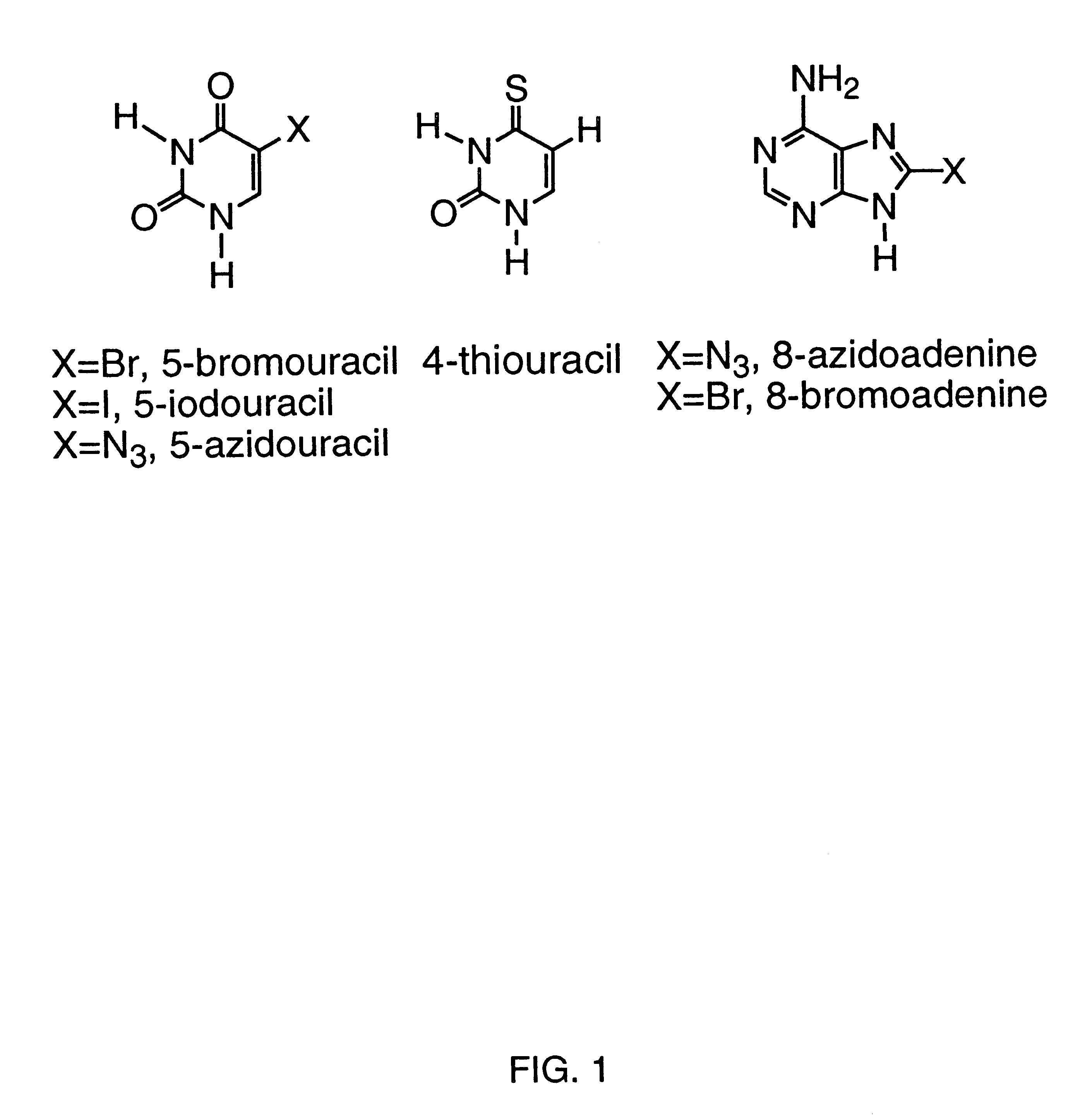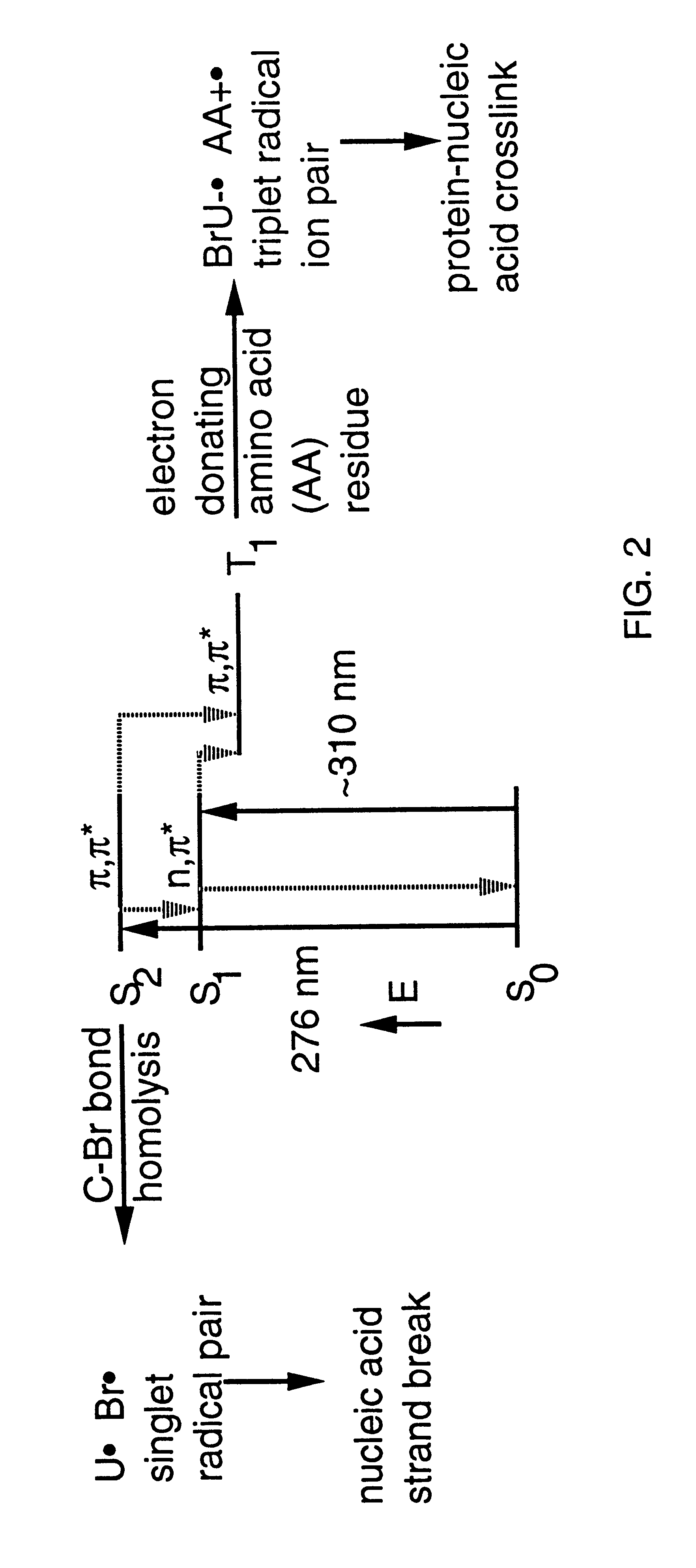Systematic evolution of ligands by exponential enrichment: photoselection of nucleic acid ligands and solution selex
a technology of nucleic acid ligands and exponential enrichment, applied in the field of systematic evolution of ligands by exponential enrichment, can solve the problem that nucleoprotein complexes which do not form crosslinks may be easily disrupted
- Summary
- Abstract
- Description
- Claims
- Application Information
AI Technical Summary
Problems solved by technology
Method used
Image
Examples
example 1
Synthesis of RNA Sequences RNA-1, RNA-2, RNA-3, and RNA-7 and R17 Coat Protein.
RNA-1 (SEQ ID NO:1), RNA-2 (SEQ ID NO:2), and RNA-3 (SEQ ID NO:3) shown in FIG. 6 and RNA-7 (SEQ ID NO:4) shown in FIG. 12 were prepared by in vitro transcription from synthetic DNA templates or plasmids using methodology described by Milligan and co-workers (Milligan et al. (1987) Nucleic Acids Res. 15:8783). Transcription reactions contained 40 mM tris(hydroxymethyl)aminomethane hydrochloride (Tris-HCl, pH 8.1 at 37.degree. C.), 1 mM spermidine, 5 mM dithiothreitol (DTT), 50 .mu.g / ml of bovine serum albumin (BSA), 0.1% (v / v) Triton X-100, 80 mg / ml of polyethylene glycol (m.sub.r 8000), and 0.1 mg / ml of T7 RNA polymerase. Larger quantities of RNA were prepared with 3-5 mM of each of the nucleotide triphosphates (NTPs), 25 mM magnesium chloride, and 1 .mu.M DNA template or 0.1 .mu.g / ml of plasmid. Body-labeled RNAs were prepared in 100 .mu.M reactions with 1 mM each of the three NTPs, 0.25 mM of the equiv...
example 2
Binding Constants for RNA-1 and RNA-2 to R17 Coat Protein.
RNA-protein binding curves for hairpin variants RNA-1 (SEQ ID NO:1), RNA-2 (SEQ ID NO:2) and RNA-3 (SEQ ID NO:3) to the bacteriophage R17 coat protein are shown in FIG. 7. The association constants between coat protein and the RNA hairpin variants were determined with a nitrocellulose filter retention assay described by Carey and co-workers (Carey et al. (1983) supra). A constant, low-concentration of .sup.32 P-labeled RNA was mixed with a series of coat protein concentrations between 0.06 nM and 1 .mu.M in 10 mM magnesium acetate, 80 mM KCI, 80 .mu.g / ml BSA, and 100 mM Tris-HCl (pH 8.5 at 4.degree. C.) (TMK buffer). These were the same solution conditions used in the crosslinking experiments. After incubation at 4.degree. C. for 45-60 min, the mixture was filtered through a nitrocellulose filter and the amount of complex retained on the filter determined by liquid scintillation counting. For each experiment the data points w...
example 3
Photocrosslinking of RNA-1 and RNA-2 to R17 Coat Protein at 308 nm.
.sup.32 P-Labeled RNA sequences RNA-1 (SEQ ID NO:1) and RNA-2 (SEQ ID NO:2) (5 nM) and R17 coat protein (120 nM) were each incubated on ice in 100 mM Tris-HCl (pH 8.5 at 4.degree. C.), 80 mM KCl, 10 mM magnesium acetate, 80 .mu.g / ml of BSA for 15-25 min before irradiations. These are conditions under which the RNA is fully bound to the coat protein. The RNAs were heated in water to 85C for 3 min and quick cooled on ice before use to ensure that the RNAs were in a hairpin conformation (Groebe and Uhlenbeck (1988) Nucleic Acids Res. 16:11725). A Lambda Physik EMG-101 excimer laser charged with 60 mbar of xenon, 80 mbar of 5% HCl in helium and 2360 mbar of helium was used for 308 nm irradiations. The output of the XeCl laser was directed unfocused toward a 4 mm wide by 1 cm path length quartz cuvette containing the RNA-protein complex. The laser was operated in the range of 60 mJ / pulse at 10 Hz; however, only about 25% ...
PUM
| Property | Measurement | Unit |
|---|---|---|
| energy | aaaaa | aaaaa |
| pH | aaaaa | aaaaa |
| affinity dissociation constants | aaaaa | aaaaa |
Abstract
Description
Claims
Application Information
 Login to View More
Login to View More - R&D
- Intellectual Property
- Life Sciences
- Materials
- Tech Scout
- Unparalleled Data Quality
- Higher Quality Content
- 60% Fewer Hallucinations
Browse by: Latest US Patents, China's latest patents, Technical Efficacy Thesaurus, Application Domain, Technology Topic, Popular Technical Reports.
© 2025 PatSnap. All rights reserved.Legal|Privacy policy|Modern Slavery Act Transparency Statement|Sitemap|About US| Contact US: help@patsnap.com



